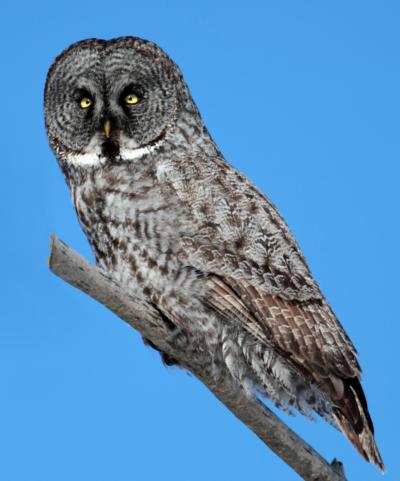 Great Gray Owl Great Gray OwlStrix
nebulosa
Description
One of the larger owls, the
great gray is 24-33 inches long, has a wingspan
of 54-60 inches, and weighs 27-52 ounces.
Ventrally, this owl is exhibits varying shades
of dark and light grays, browns, and white. The
dorsal side has a little less white than the
ventral side. There is an obvious facial disk,
with many dark concentric rings. Distinctive
marks include a black chin spot above two white
"mustaches" and prominent white collar
on the front of the neck.
Distribution and
Habitat
The great gray owl has a
circumpolar range that in North America includes most
of Alaska and Canada, the higher elevations of
the Rocky Mountain States, northern Minnesota,
and northern Wisconsin It also occurs widely
across northern Europe and Asia. It generally
prefers pine and fir forests, but can also be
found in sparse woodland edges bordering open
fields, weedy fields with posts or scattered low
trees or bushes, and brackish tidal meadows.
Diet
This owl hunts by perching on a tree (or other
suitable vantage point) overlooking a meadow or
open area. Keen hearing enables it to accurately
determine the location of its prey, even under
two feet of snow or in tunnels. Once the owl
locates some food, it silently glides from its
perch and grabs the prey with its sharp talons.
This owl can plunge through up to two feet of
snow to get its prey. Small rodents comprise
80-90% percent of the diet, with other mammals
(mainly shrews) and birds making up the rest.
Reproduction
Courtship involves feeding and mutual preening
between mates and begins in midwinter. The male
selects possible nest sites and attracts its mate
with calls. Several sites are inspected before
she chooses the nest site. The great gray owl
nests primarily in stick nests made by hawks,
ravens, or crows, in the hollowed out top of
large-diameter snags, or on the top of clumps of
mistletoe, and in Europe sometimes on the forest
floor.
Two to five dull white oval eggs are laid
sometime between March and June. They are
incubated by the female alone for 28-29 days,
during which time the male brings her food. The
owlets hatch covered by soft white down with
their eyes open. The male does all of the hunting
while the owlets are in the nest, but the feeding
is usually done by the female, who tears the prey
into pieces small enough for the owlets to
swallow. Young leave nest after three to four
weeks with the ability to climb well.
Other Information
Great gray owls are most active at night, but
also at dusk and just before dawn. They are
sometimes active during the day in breeding
season.
This owl does not migrate, but it will move in
response to rodent populations.
Great gray owls fly with soft, slow wingbeats
and generally do not often move more than short
distances between perches and seldom glide. They
fly close to the ground, usually less than 20
feet up, except when flying to a nest.
The distinctive primary call is a very soft,
low-pitched hoot "whooo-ooo-ooo-ooo"
with the notes emitted slowly over a 6 to 8
second period. Calls are repeated every 15 to 30
seconds. This call is used as a territorial
declaration and can be heard up to a half mile
away under good conditions. Territorial calling
begins after dusk, peaks before midnight, then
peaks again later. Males and females also give a
single hoot when near the nest. Females give an
excited "ooo-uh" when the male
arrives with food. When excited near the nest
adults growl, shriek, hoot, wail, and snap their
bills.
The great gray owl is the official bird emblem
of Manitoba, Canada.
Scientific
Classification
phylum Chordata
subphylum Vertebrata
class
Aves
order
Strigiformes
family Strigidae
genus & species Strix nebulosa

Animal Diversity Web http://animaldiversity.org/accounts/Strix_nebulosa/
The Owl Pages http://www.owlpages.com/owls/species.php?s=1770
Questions or comments about
this page?
|



